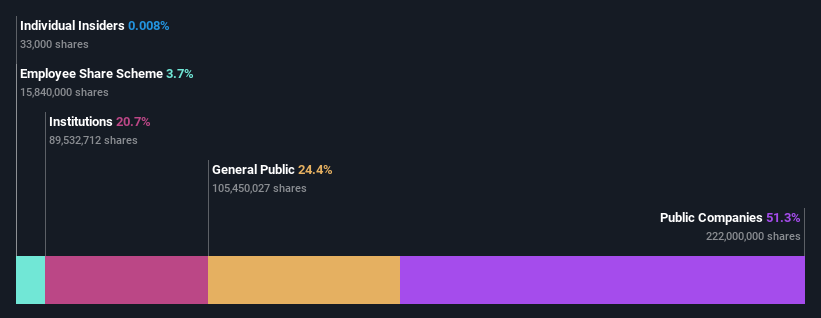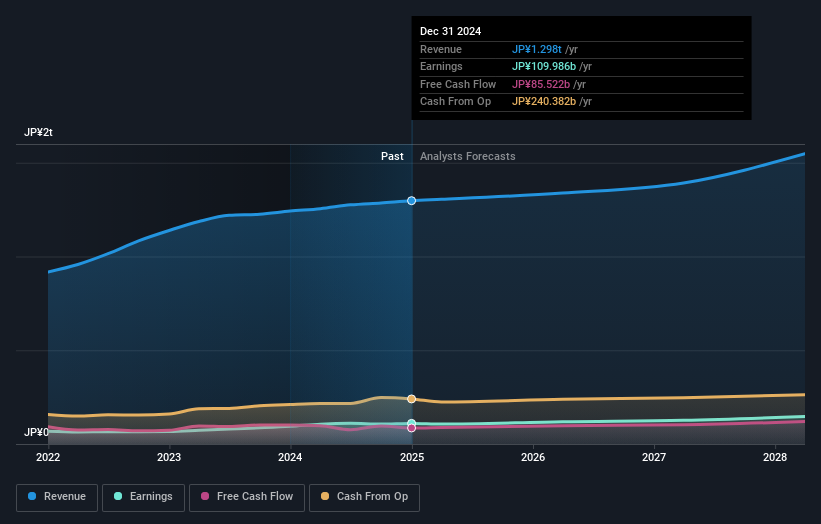Nippon Sanso Holdings Corporation's (TSE:4091) largest shareholders are public companies with 51% ownership, individual investors own 24%

Key Insights
- Significant control over Nippon Sanso Holdings by public companies implies that the general public has more power to influence management and governance-related decisions
- 51% of the company is held by a single shareholder (Mitsubishi Chemical Group Corporation)
- Institutional ownership in Nippon Sanso Holdings is 21%
If you want to know who really controls Nippon Sanso Holdings Corporation (TSE:4091), then you'll have to look at the makeup of its share registry. And the group that holds the biggest piece of the pie are public companies with 51% ownership. That is, the group stands to benefit the most if the stock rises (or lose the most if there is a downturn).
Individual investors, on the other hand, account for 24% of the company's stockholders.
In the chart below, we zoom in on the different ownership groups of Nippon Sanso Holdings.
View our latest analysis for Nippon Sanso Holdings

What Does The Institutional Ownership Tell Us About Nippon Sanso Holdings?
Institutional investors commonly compare their own returns to the returns of a commonly followed index. So they generally do consider buying larger companies that are included in the relevant benchmark index.
We can see that Nippon Sanso Holdings does have institutional investors; and they hold a good portion of the company's stock. This suggests some credibility amongst professional investors. But we can't rely on that fact alone since institutions make bad investments sometimes, just like everyone does. If multiple institutions change their view on a stock at the same time, you could see the share price drop fast. It's therefore worth looking at Nippon Sanso Holdings' earnings history below. Of course, the future is what really matters.

Hedge funds don't have many shares in Nippon Sanso Holdings. The company's largest shareholder is Mitsubishi Chemical Group Corporation, with ownership of 51%. This essentially means that they have extensive influence, if not outright control, over the future of the corporation. Meanwhile, the second and third largest shareholders, hold 3.7% and 2.1%, of the shares outstanding, respectively.
While it makes sense to study institutional ownership data for a company, it also makes sense to study analyst sentiments to know which way the wind is blowing. There are plenty of analysts covering the stock, so it might be worth seeing what they are forecasting, too.
Insider Ownership Of Nippon Sanso Holdings
While the precise definition of an insider can be subjective, almost everyone considers board members to be insiders. The company management answer to the board and the latter should represent the interests of shareholders. Notably, sometimes top-level managers are on the board themselves.
Insider ownership is positive when it signals leadership are thinking like the true owners of the company. However, high insider ownership can also give immense power to a small group within the company. This can be negative in some circumstances.
Our data suggests that insiders own under 1% of Nippon Sanso Holdings Corporation in their own names. As it is a large company, we'd only expect insiders to own a small percentage of it. But it's worth noting that they own JP¥151m worth of shares. In this sort of situation, it can be more interesting to see if those insiders have been buying or selling.
General Public Ownership
The general public, who are usually individual investors, hold a 24% stake in Nippon Sanso Holdings. While this group can't necessarily call the shots, it can certainly have a real influence on how the company is run.
Public Company Ownership
It appears to us that public companies own 51% of Nippon Sanso Holdings. We can't be certain but it is quite possible this is a strategic stake. The businesses may be similar, or work together.
Next Steps:
It's always worth thinking about the different groups who own shares in a company. But to understand Nippon Sanso Holdings better, we need to consider many other factors. Consider for instance, the ever-present spectre of investment risk. We've identified 1 warning sign with Nippon Sanso Holdings , and understanding them should be part of your investment process.
If you would prefer discover what analysts are predicting in terms of future growth, do not miss this free report on analyst forecasts.
NB: Figures in this article are calculated using data from the last twelve months, which refer to the 12-month period ending on the last date of the month the financial statement is dated. This may not be consistent with full year annual report figures.
Valuation is complex, but we're here to simplify it.
Discover if Nippon Sanso Holdings might be undervalued or overvalued with our detailed analysis, featuring fair value estimates, potential risks, dividends, insider trades, and its financial condition.
Access Free AnalysisHave feedback on this article? Concerned about the content? Get in touch with us directly. Alternatively, email editorial-team (at) simplywallst.com.
This article by Simply Wall St is general in nature. We provide commentary based on historical data and analyst forecasts only using an unbiased methodology and our articles are not intended to be financial advice. It does not constitute a recommendation to buy or sell any stock, and does not take account of your objectives, or your financial situation. We aim to bring you long-term focused analysis driven by fundamental data. Note that our analysis may not factor in the latest price-sensitive company announcements or qualitative material. Simply Wall St has no position in any stocks mentioned.
About TSE:4091
Nippon Sanso Holdings
Engages in the gas business in Japan, the United States, Europe, Asia, and Oceania.
Adequate balance sheet with moderate growth potential.
Similar Companies
Market Insights
Community Narratives



